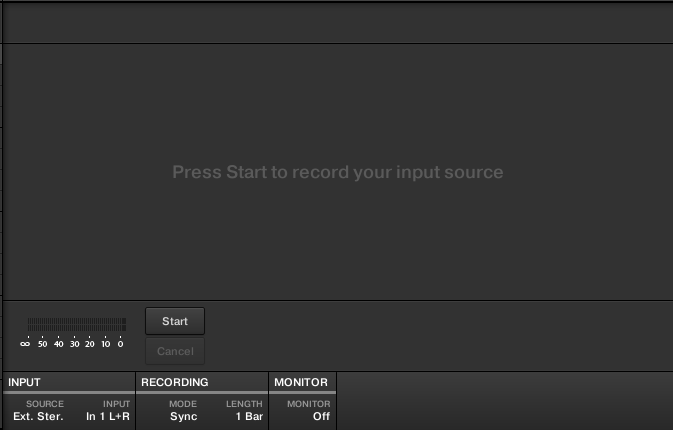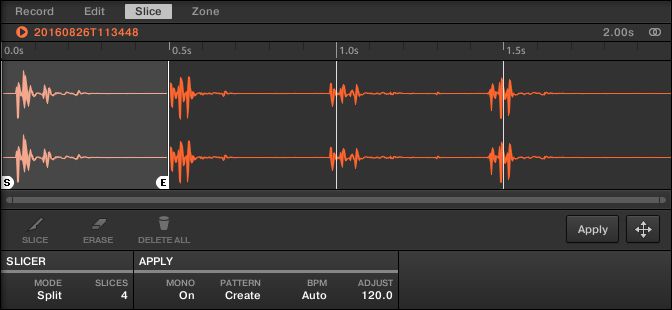Sampling and sample mapping
Sampling is an integral part of the Maschine environment. This section discusses Maschine Software's powerful Sample Editor, from recording to editing, slicing, and layering.
Maschine allows you to record internal or external audio signals without having to stop the sequencer. This is a helpful feature if you want to record your Samples or rearrange loops that you have created yourself using Maschine.
You can apply various types of destructive processing to the recorded audio or to any Sample you want to use in a Sound.
The slicing feature allows you to slice loops to make them playable at any tempo without changing their pitch or timing. It is also useful if you want to quickly extract single Samples from loops (for example., a snare sound from a drum loop) or rearrange loops by editing or muting their Slices, changing the order of the Slices, applying a different quantization, or adding Swing.
Last but not least, you can map your Samples to particular Zones, thereby creating multi-sample Sounds with individual velocity and note ranges, volume, and panning. This is useful to emulate the behavior of classic instruments and synthesizers and allows for a large number of Samples in only one Sound.
All this can be done in the Sample Editor.
Opening the Sample Editor
To access the Sample Editor in the software, do the following:
In the Sound List left of the Pattern Editor, click the desired Sound to put it under focus. For more information, refer to Focusing on a Group or a Sound.
Click the Sample Editor button on the left of the Pattern Editor to switch to the Sample Editor.

The Sample Editor appears and displays the Sample content of the focused Sound.
In the Sample Editor, click the desired tab at the top to access the corresponding page:
The Record page allows you to record audio: Recording audio.
The Edit page allows you to apply destructive edits to existing Samples: Editing a Sample.
The Slice page allows you to create Slices from your existing Samples: Slicing a Sample.
The Zone page allows you to assign your Samples to particular note and velocity ranges (called Zones) in your Sound and to adjust various playback settings for each Zone individually: Mapping Samples to Zones.
Recording audio
Maschine provides everything you need to record audio.
Opening the Record page
Selecting the source and the recording mode
At the bottom of the Record page, the INPUT section and the RECORDING section allow you to select which source should be recorded and how the recording should be made.

Adjusting the source and mode of the recording in the software.
Choosing a recording mode
Click the MODE selector in the RECORDING section to select from the four available recording modes:
Detect: Select Detect mode to record audio after the set threshold has been exceeded. This is useful when you want to record audio without the silence before the incoming sound is played. If the focused Sound Slot contains neither an Audio nor Sampler plug-in, the recorded audio will automatically be loaded into a Sampler plug-in for the first Take. After that, you must trigger the Sampler with MIDI Events, such as those in a Pattern, to playback the audio.
If Detect is selected, you can set a specific threshold using the level THRESHOLD control on the right. After clicking Start, any input signal level exceeding this threshold will start the recording. You can then manually stop the recording by clicking Stop. You can also adjust the threshold by dragging the slider that appears on the horizontal input level meters above the RECORDING section: Any input level reaching the slider position will start the recording. Double-click the slider to reset the threshold to its default value (-12 dB).
Sync: Select Sync to start recording audio in time with the Pattern Grid. If the focused Sound Slot contains neither an Audio nor a Sampler plug-in, the recorded Sample will be loaded automatically into a Sampler plug-in as the first Take. After that, you must trigger the Sampler with MIDI Events to playback the audio.
When Sync is selected, the recording starts in sync with the sequencer after clicking Start. The recording will begin at the start of the next bar. The LENGTH control on the right allows you to choose a length for the recording: either 1, 2, 4, 8, or 16 bars, or choose Free if you do not want to set a duration limit to the recording. You can click Stop to end recording at any time, and the recording will stop at the next bar.
Loop: Select Loop to record audio that you intend to play back in sync with your Project using the Audio plug-in. It records audio in the same way as Sync. However, when Loop mode is selected, an additional parameter appears called Target. In Loop mode, the recording is loaded into an Audio plug-in so that you can immediately hear the results. The Target parameter dictates how Maschine loads new recordings into the Audio plug-in:
Take: Select this to record each new Take into the focused Sound slot. After a Take is recorded, it will become visible in the Audio Pool and is automatically selected for playback. You can review all the Takes you’ve captured in the Audio Pool, and you can also select any of these Takes to make it the one that actively plays back in the Audio plug-in.
Sound: Select this Target to enable a layered workflow similar to that achieved with guitar loop pedals. When using this mode, each recording that you make will be loaded into an empty Sound Slot in the current Group and Pattern and will begin playing back. Therefore, each recording that you make will playback layered on top of all the previous recordings made in that particular Group and Pattern. By layering each new Take onto a new Sound, you can quickly build a whole pattern. You can continue this process until all empty Sound slots in the Group are used up. After that, each additional recording will be recorded as a new Take into the last Sound of the Group that contains an Audio plug-in (and the previous Takes will still be preserved if you want to switch back to them).
Pattern: Select this Target to record similar to the Sound Target described above, except that each new recording will also be assigned to a new Pattern. This mode can be helpful when you want to record different variations of a part and then review the variations quickly by playing each Pattern. For example, the first recording will be placed into an Audio plug-in in the first available Sound Slot in the Group, and then a new Pattern will be created where only this new recording is playing back. Making another recording will result in the recording being loaded into another unused Sound Slot, and another new Pattern will be made where only this most recent recording is playing. If you switch back to the previous Pattern, you’ll hear only the previous recording (the newest will automatically be deactivated in the previous Pattern).
Auto: Select this recording mode if you want to automatically sample an external or internal synthesizer. After selecting this mode, further options are available for setting the notes' stride (interval), key range, and velocity. You can also let Maschine Software batch process the samples to automatically find the best loop points, trim silence from the start and endpoints, and normalize the sound level. Refer to Auto Sampler.
Selecting the input source to record
Click the SOURCE selector in the INPUT section to select the type of source you want to record:
To record external audio signals connected to your audio interface, select Ext. Ster. (for stereo signals) or Ext. Mono (for mono signals).
To record audio signals coming from Maschine itself, select Internal.
Click the INPUT selector to choose between the available source inputs:
Ext. Ster.: Selects either of Maschine’s four external stereo inputs In 1–4.
Ext. Mono: Selects either of Maschine’s eight external mono inputs: the left (“L”) or right (“R”) channel of each input pair In 1–4.
Internal: Selects the output of any available Group or the Master.
Tip
You can easily record the output of a particular Sound by setting SOURCE to Internal, soloing this Sound, and selecting its parent Group in the INPUT selector.
Tip
You can also set SOURCE to Internal, choose as INPUT a Group with a drum kit loaded, and record your live improvisations on the pads while playing this drum kit. You will then have your improvisations recorded as Samples, ready to be used, edited, sliced, etc., as any other Samples in Maschine.
Monitoring the input signal

Visually controlling the input signal.
The level meters above the RECORDING section show you at any time the level of the selected audio source. For example, this can come in handy to adjust the appropriate threshold in Detect mode. For this purpose, in Detect mode, the level meters also provide a fader adjusting the threshold level for this purpose. This fader is a strict equivalent to the THRESHOLD control described above. This way, you can easily visualize when the input signal exceeds the current threshold (and hence, when it would start the recording) and adjust that threshold accordingly.

Monitoring the input signal.
Furthermore, if you have selected an external signal (Ext. Ster. or Ext. Mono selected in SOURCE), an additional MONITOR section appears on the right. In this section, activate the MONITOR button to send the input signal to the Cue bus of Maschine, allowing you to hear on a separate channel (for example, your headphones) the audio source that is about to be recorded.
Notice
For more information on using the Cue bus, please refer to section Using the Cue bus.
Arming, starting, and stopping the recording

The Start and Cancel buttons.
Click Start to arm the recording.
After the recording has been armed, its behavior will depend on the recording mode you have selected (via the MODE selector, refer to section Selecting the source and the recording mode above):
When recording in Detect mode:
The recording will start as soon as the input signal exceeds the THRESHOLD value. Until then the Start button turns to a Waiting button and the Waiting for input… message appears in the information bar above the waveform display. During this waiting phase you can also start the recording manually by clicking the Waiting button or cancel the recording by clicking Cancel.
Once the recording has started, click Stop to stop the recording (it stops immediately) or Cancel to cancel the recording (the recorded audio will not be saved).
When recording in Sync mode:
The recording will start at the next bar. Until then the Start button reads a flashing Waiting label and the Waiting for the next bar… message appears in the information bar above the waveform display.
Once the recording has started, the audio is recorded for the duration set by the LENGTH control (refer to Selecting the source and the recording mode above). You can also click Stop beforehand to stop the recording at the next bar, or Cancel to cancel the recording (in that case the recorded audio will not be saved).
When recording in Loop mode:
The recording will start at the beginning of the Pattern. Until then the Start button reads a flashing Waiting label and the Waiting for end of Pattern… message appears in the information bar above the waveform display.
Once the recording has started, the audio is recorded for the duration set by the LENGTH control (refer to Selecting the source and the recording mode above). You can also click Stop beforehand to stop the recording at the next bar, or Cancel to cancel the recording (in that case the recorded audio will not be saved).
Tip
If you want to start and stop the recording manually, you can set the MODE to Detect, dial the THRESHOLD down to OFF, and start the recording by clicking Start. To stop recording, click Stop.
In any case the recorded audio will be stored in the Sound that was under focus as you started the recording.
When Recording is Complete
When the recording is done, the following things happen:
Each Take is named and stored as a file on your hard disk (refer to Location and name of your recorded Samples).
Its waveform appears in the waveform display and its name appears in the information bar above.
The recording is automatically appended to the Audio Pool of the Sound and selected (refer to Checking your recordings below).
A Sampler Plug-in is automatically loaded in the first Plug-in slot of the Sound, ready to play your new recording. All Plug-ins previously loaded in that Sound are removed. However, when recording in Loop mode, an Audio plug-in will be loaded. If there was already a Sample Plug-in in the Slot when engaging Loop recording, it will not change the Sampler to an Audio plug-in, it will remain as a Sampler and you will need to manually change the plug-in to Audio if you wish. In this case all recorded takes will be preserved.
The Sound slot takes the name of your recording.
If the Sampler Plug-in was used in Detect mode or Sync mode, the recording is mapped to a new Zone covering the entire key and velocity ranges in the Zone page, which makes your new sample directly playable from the pad of its Sound slot (or from all your pads if pads are in Keyboard mode). Any existing Zones will be replaced. The sample must then be triggered using MIDI Events in the Pattern Editor. For more information on Zones, refer to section Mapping Samples to Zones.
If the Audio Plug-in was used in Loop mode, the last recorded Take will automatically play back with the Pattern.
Notice
Note that any MIDI Events for that Sound in the current Pattern will remain. As a consequence, your recording might directly start to play at the pitch defined by the existing MIDI Events.
Checking your recordings
You can visualize the last recordings you have made in the current Sound:
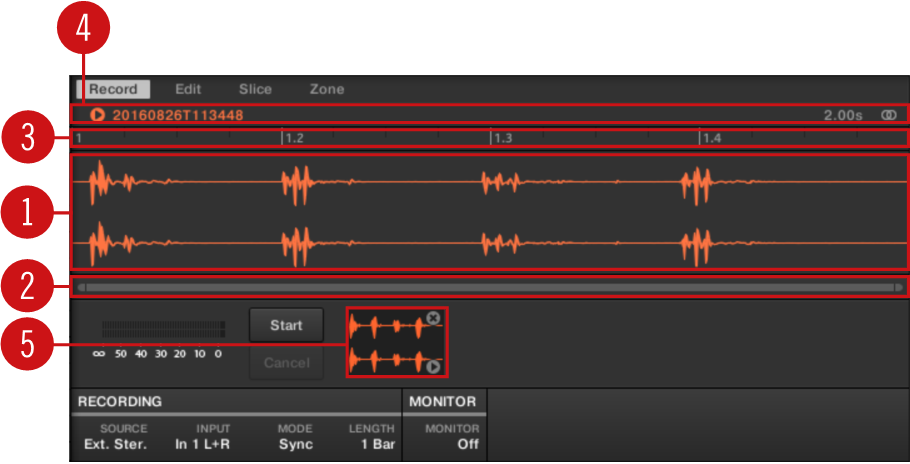
The waveform display and the information bar displaying a recording.
(1) Waveform display
Shows the waveform of the recording currently selected in the Audio Pool (5) — by default your last recording:
Use the scroll wheel of your mouse to zoom in/out. You can also use the zooming scroll bar (2).
When the Sample is played back (e.g., by pressing the pad or by clicking the little play icon in the information bar (4)), a playhead indicator (white vertical line) shows you the current play position within the waveform.
Right-click (macOS: [Ctrl]-click) anywhere in the waveform to open a context menu with the following commands:
Command | Description |
|---|---|
Open containing folder | Opens the folder on your hard disk containing the Sample, providing quick access to the original file. |
Save Sample As… | Opens a Save Sample As dialog allowing to save the recorded Sample under another name and/or to another location on your computer. |
(2) Zooming scroll bar
Click the main part of the scroll bar and drag your mouse horizontally to scroll through the waveform on the horizontal axis (time), or drag it vertically to zoom in/out on the same time axis. You can also click the left or right handle of the scroll bar and drag it horizontally to zoom in/out while keeping the opposite border of the display at a fix position in the waveform. Double-click the main part of the bar to reset the zoom and display the entire waveform. Alternatively you can use the scroll wheel of your mouse when hovering the waveform display (1) to zoom in/out.
(3) Timeline
Shows the time scale in bars (Sync mode) or seconds (Detect mode).
(4) Information bar
Displays the file name and the length of the recorded Sample. Click and hold the little play icon on the left to listen to the Sample on the Cue bus (refer to Using the Cue bus for more information). Click the little circle (or pair of circle) at the far right to switch the waveform display (1) between single-channel and two-channel display.
(5) Audio Pool
All the takes you have made since you opened the current Project are stored in the Audio Pool and displayed as mini waveforms under the waveform display. The following actions are available:
Click any take to display the recording, you can then further edit this recording via the other pages of the Sample Editor. When selected, a recording is also automatically mapped to a new Zone covering the entire key and velocity ranges in the Zone page. Any existing Zones will be replaced.
Note
In the Audio Plug-in, changing the selected take only affects the current Pattern. The other Patterns remain unchanged.
Click and hold the little play icon in the bottom right corner to listen to the Sample on the Cue bus without loading it in the waveform nor in the Zone page.
Click the little cross at the top right corner of a mini waveform to delete this particular recording.
Drag any mini waveform to another Sound slot to load it in that Sound.
Right-click (macOS: [Ctrl]-click) any mini waveform in the Audio Pool to open a context menu with the following commands:
Command | Description |
|---|---|
Delete | Deletes the displayed take from the Audio Pool. This has the same effect as clicking the little cross at the top right corner of the selected mini waveform in the Audio Pool. |
Remove unused recordings | Deletes from the Audio Pool all takes that are not currently mapped to any Zone in the Zone page. |
Map recordings to zones | Automatically maps all recordings of the Audio Pool to Zones in the Zone page. The created Zones are put on adjacent keys and cover the entire velocity range. Any existing Zones will be replaced. |
Notice
All recordings (takes) in the Audio Pool are saved with the Project. When you close the current Project, all of your takes are saved as audio files and available for later use in the Audio Pool, unless you explicitly delete them (via the Maschine software or in your operating system).
Location and name of your recorded Samples
By default, recorded Samples (takes) are saved in the Recordings subfolder of your Standard User Directory, as defined on the User pane of the Library page in the Preferences panel (see Preferences – Library page). If you activate the Prefer Project Folder option on the General page of the Preferences panel (see Preferences – General page), recorded Samples will be saved instead in a Recordings subfolder of the folder where your current Project is saved.
Recorded Samples are automatically named using the following scheme:
[YYMMDD]T[HHMMSS].wav
In the name above, [YYMMDD] stands for the current date (year, month, day, all 2-digit numbers) and [HHMMSS] for the current time (hours, minutes, seconds, all 2-digit numbers).
Auto Sampler
Auto Sampler makes it easy to create sampler instruments that you can use in Maschine Software. You can create a sampler instrument from a MIDI-capable hardware synthesizer, a software instrument, or a combination of synthesizers, hardware effects, and effect plug-ins.
Sampling instruments is a great way to capture other instruments and save on CPU resources, especially when sampling instruments that have effects. Used creatively, you could also turn any monophonic synthesizer into a polyphonic powerhouse.
Instruments created with Auto Sampler can be saved as a Sound and all its samples. This is a great way to share your sampled instruments with other Maschine users or between Maschine+ and your desktop.
Note
Using effects when creating a sampler instrument is a creative process but is different from using effects in real-time in two ways: first, effects are applied to each sampled note, not on multiple notes or chords; and second, effects parameters cannot be edited or automated to produce changes in the sound over time.
Before using the Auto Sampler, you must first set up the devices you want to record and access the Recording mode of the Sampler. Refer to Creating a sampled instrument using Auto Sampler for more information.
Creating a sampled instrument using Auto Sampler
To create a sampled instrument using Auto Sampler:
Click the Sample icon to access the Sampler Editor. Refer to Opening the Sample Editor.
Select Auto from the Recording mode field at the bottom of the interface. Refer to Selecting the source and the recording mode.
Recording an external instrument
If you are sampling an external device such as a synthesizer, connect the instrument to your Maschine (audio and MIDI), then select Input Source to External. Refer to Input.
Ensure that Maschine can receive audio input from the external device on the correct audio input. Refer to Monitor.
Recording an internal instrument
If you want to sample a Plug-in, select Input Source to Internal and the Input to Group and Sound of the plug-in you want the Auto Sampler to capture. Refer to Input.
Once you have set up the Auto Sampler, you can make settings regarding the notes, velocities, and batch processing you want Auto Sampler to perform. Refer to
Recording
The recording section enables you to set the recording mode, the sample length, and the note length of the sample you want to record.
Setting | Description |
|---|---|
MODE | Sets the recording mode of the Sampler. Select Auto to use Auto-Sampler. |
SAMPLE | Sets the length of time Auto-Sampler records samples. For example, choose short times for percussive sounds or bass stabs, and longer times for strings and pads. If you want to loop your sound, it is helpful to record for longer to give Maschine enough material to find the best loop points. For the best results, use this parameter in conjunction with the NOTE ON parameter. |
NOTE ON | Sets the length of time Auto-Sampler triggers the instrument it is recording. For the best results, use this parameter in conjunction with the SAMPLE parameter. |
Input
The Input section lets you set the source you want to record and select the MIDI device and channel when triggering external MIDI instruments.
Setting | Description |
|---|---|
SOURCE | Ext. Ster.: Selects external stereo inputs as the recording source type. Ext. Mono: Selects external mono inputs as the recording source type. Internal: Selects the internal output Maschine as the recording source type. |
INPUT | Ext. Mono: Selects either of Maschine’s eight external mono inputs: the left (“L”) or right (“R”) channel of each input pair In 1–4. Ext. Ster.: Selects either of Maschine’s four external stereo inputs In 1–4. Internal: Selects the output of any available Group or the Master channel. |
MIDI TO | Sets the MIDI port you want to use when connecting to external MIDI equipment. All available devices are shown here. |
CHANNEL | Sets the MIDI channel to match the MIDI channel of the external equipment you want to sample. Maschine will use this to trigger the sound when making recordings. |
Note Map
The Note Map section enables you to set the number of notes and the range of the keyboard covered by each sample.
Setting | Description |
|---|---|
STRIDE | Sets the number of notes that each sample will cover. A Stride value of 1 records every note within the Key Lo and Key Hi range. For example, a Stride of 5 to accurately capture every note in the Key Lo and Key Hi range. Alternatively, you could set a higher Stride value, resulting in fewer samples. A value of 12, for example, would cover 12 notes, meaning one sample would be stretched across a range of notes. This could result in possible pitch artifacts, but the value you select depends on the sound you want to achieve. |
KEY LO | Sets the lowest note of the sample note range. |
KEY HI | Sets the highest note of the sample note range. |
EXTEND | Extends the highest and lowest samples to include the whole range of the keyboard. |
Velocity Map
The Velocity Map section lets you set the velocity covered by each sample within the velocity range.
Setting | Description |
|---|---|
STRIDE | Sets the velocity range each sample will cover as the Auto-Sampler triggers sounds. If, for example, you wanted to capture every nuance of sound, you could use a Stride value of 1 to record every velocity set within the Vel Lo and Vel Hi range. Alternatively, you could set a higher Stride value, resulting in fewer samples for a broader sample of the sound. |
VEL LO | Sets the lowest velocity value you want to sample. |
VEL HI | Sets the highest velocity you want to sample. |
EXTEND | Extends the upper and lower velocity values to include the full velocity range of the instrument. |
Batch Process
The Batch Process section provides a set of time-saving tools that help you by automating the process of looping, trimming, and normalizing your samples.
Setting | Description |
|---|---|
FIND LOOP | Automatically finds the best loop point in your samples. This feature is useful if you want to create sustained sounds such as pads or strings. |
TRIM SILENCE | Automatically removes unwanted silence from the beginning and end of each sample. |
NORMALIZE | Adjusts the level of each sample to the maximum possible value without clipping. Normalizing audio is useful for making samples more consistent in volume. |
Monitor
The Monitor section enables you to hear the output of the Auto-Sampler.
Setting | Description |
|---|---|
MONITOR | Activates the monitor, which enables you to hear the Auto-Sampler as it works through the process of capturing samples. |
Editing a Sample
The Edit page of the Sample Editor in the software and its equivalent the EDIT page of the Sampling mode on your controller allow you to adjust the start and end points of a Sample or Slice and to apply various destructive audio processing functions to any part of the Sample.
Which Sample is shown in the Edit page?
The Edit page (EDIT page on your controller) always displays the Sample of the Zone currently selected (refer to Selecting and managing Zones in the Zone List for more information on selecting Zones), and all your actions in that page will affect this particular Sample. For example:
If you have just recorded a Sample, it will directly appear here. If you have recorded more than one Sample, the Sampled selected in the Audio Pool (by default the last recorded Sample) will appear here. Refer to Checking your recordings for more information on the Audio Pool.
If the Sample in that Sound is already split into Slices, each Slice has its own Zone and the Slice of the focused Zone will appear here. Refer to Slicing a Sample for more information on slicing Samples.
Using the Edit page
In the Sample Editor, click the Edit tab at the top to open the Edit page.
The Edit page looks as follows:
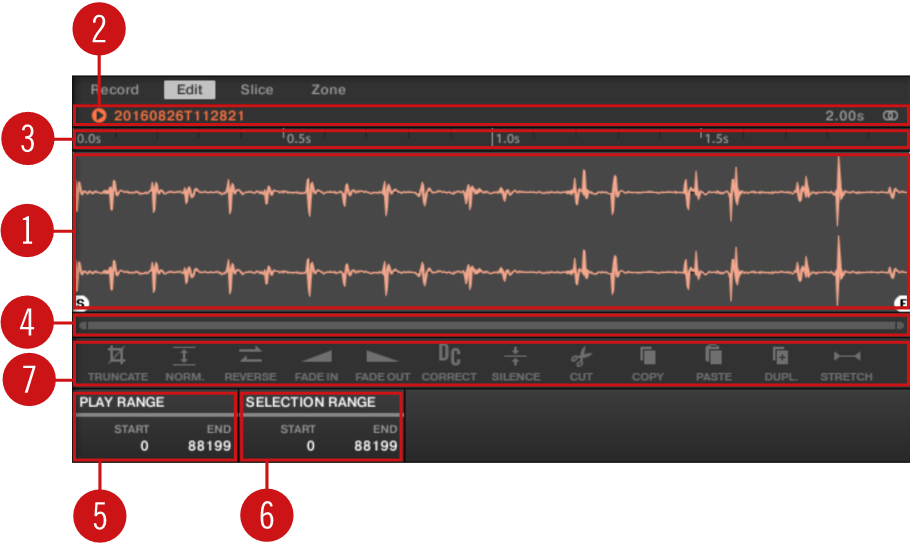
The Edit page in the software.
(1) Waveform display
Shows the waveform of the Sample for the focused Zone. The waveform display provides following tools:
Drag any Sample onto the waveform to replace the current Sample for the focused Zone. If there is no Sample loaded yet, this automatically loads a Sampler Plug-in in the Sound and creates a Zone over the entire key and velocity ranges for the dragged Sample.
Use the scroll wheel of your mouse to zoom in/out. You can also use the zooming scroll bar (4).
Play range: The S and E markers indicate the start and end points of the play range, respectively. Drag them with the mouse to modify the portion of the Sample that will be played back. This can also be done using the controls in the PLAY RANGE section (5).
Loop range: If a loop has been defined in the Sample, it is also indicated on the waveform. You can then adjust the loop by dragging its borders, and move the entire loop by dragging its title bar. Loops can be created and adjusted in the Zone page — see section Selecting and editing Zones in the Map view. Note that the loop will always stay within the play range. Therefore, when moving the Sample’s start and end points closer to each other, keep in mind that it might also shrink the loop!
Playhead indicator: When the Sample is played back (e.g., by pressing the pad or by clicking the little play icon in the information bar (2)), a playhead indicator (white vertical line) shows you the current play position within the waveform.
Selection range: Click and drag your mouse to create a selection range. The selection range defines the portion to which the audio processing functions of the Audio Toolbar (7) will be applied. Adjust the current selection range by dragging its borders or move it by dragging its top part. Double-click anywhere in the waveform to set the selection range to the play range (i.e. to select everything between the S and E markers). You can also select particular ranges via the context menu (see below) and via the controls in the SELECTION RANGE section (6).
Context menu: Right-click (macOS: [Ctrl]-click) anywhere in the waveform to open a context menu with the following commands:
Command | Description |
|---|---|
Deselect | Cancels the current selection range. |
Select All | Selects the entire Sample. |
Select Play Range | Selects the play range, i.e. the region between the S and E markers. This is equivalent to double-clicking anywhere in the waveform. |
Select Loop | Selects the loop range. |
Find in Explorer | Opens the folder on your hard disk containing the Sample, providing quick access to the original file. |
Save Sample As… | Opens a Save Sample As dialog allowing to save the Sample under another name and/or to another location on your computer. |
(2) Information bar
Displays the file name and the length of the recorded Sample. Click and hold the little play icon on the left to play back the whole Sample on the Cue bus (refer to Using the Cue bus for more information). Click the little circle (or pair of circle) at the far right to switch the waveform display (1) between single-channel and two-channel display.
(3) Timeline
Shows the time scale in seconds.
(4) Zooming scroll bar
Click the main part of the scroll bar and drag your mouse horizontally to scroll through the waveform on the horizontal axis (time), or drag it vertically to zoom in/out on the same time axis. You can also click the left or right handle of the scroll bar and drag it horizontally to zoom in/out while keeping the opposite border of the display at a fix position in the waveform. Double-click the main part of the bar to reset the zoom and display the entire waveform. Alternatively you can use the scroll wheel of your mouse when hovering the waveform display (1) to zoom in/out.
(5) PLAY RANGE section
Adjusts the range that will be played when you trigger a note. Adjust the play start and end points in the Sample via the Start and End parameters. You can also do it by dragging the white markers labeled S and E on the waveform display (1) using the mouse as described above.
(6) SELECTION RANGE section
Adjusts the range to which audio processing functions will be applied. You can also select the range by dragging your mouse on the waveform display (1) as described above.
(7) Audio Toolbar
Provides a set of destructive audio processing functions to modify your Sample. The functions will be applied to the current selection range. The available functions are described in section Audio editing functions below.
Tip
You can also edit the play and loop ranges on the Zone page. See section Adjusting the Zone settings for more information.
Audio editing functions
In the Edit page, the Audio Toolbar provides various audio functions. These will be performed on the selected region of the Sample, as defined by the Start and End parameters of the SELECTION RANGE section (refer to Using the Edit page above).
To apply any audio function to the selected region in your Sample, click the desired icon in the Audio Toolbar.
Tip
Most of these audio processing functions are destructive: They modify the audio material in the Sample. However, your original Sample will not be modified: For each audio function that you perform, a new, distinct copy of the Sample will be saved. Besides, you can always cancel your last action(s) by pressing [command] + [Z] (Mac) or [Ctrl] + [Z] (Windows) on your computer keyboard.
Notice
The playback settings of the Sample (e.g., tune, amplitude envelope, etc.) can be adjusted on the Zone page. See section Selecting and editing Zones in the Map view for more information.

The Audio Toolbar.
The Audio Toolbar provides following audio processing functions:
Command | Description |
|---|---|
Truncate | Deletes the part of the Sample that is outside of the selected region. |
Norm. (Normalize) | Adjusts the level of the selected region to the maximum possible value without clipping. |
Reverse | Reverses the selected region of the Sample. |
Fade In | Applies a fade in to the selected region of the Sample. |
Fade Out | Applies a fade out to the selected region of the Sample. |
Correct | Removes the DC offset. DC offset (“Direct Current offset”) is an undesirable constant shift in the signal level that might be introduced by some audio processing units. This offset can notably waste some of the available headroom. |
Silence | Silences the selected region of the Sample. |
Cut | Deletes the selected region from the Sample and places it into the clipboard for later use. |
Copy | Copies the selected region of the Sample to the clipboard for later use. |
Paste | Pastes the cut/copied region of the Sample, replacing the region of the Sample currently selected. |
Dupl. (Duplicate) | Duplicates the selected region of the Sample. The copy is placed right after the original region. |
Stretch | Allows you to apply time stretching and/or pitch shifting to the selected region of the Sample. See below for a detailed description. |
Stems | Separates the Sample into four distinct components or “stems”: drums and percussion, bass, other, and vocals. The third stem (“other”) is what remains in the Sample after removing all other stems, and can vary from Sample to Sample. When you click Stems, the icon switches to a percentage value indicating the progress of the stem separation. This processing runs in the background and you can continue with other work until the separation has been completed. You can also click Cancel at any time to cancel the separation process. Upon completion, a new Group will automatically be created, with its first four Sound slots containing the four stems (drums, bass, vocals, other) loaded in Sampler modules, ready to be played. The stems will appear as individual Samples in the user content of your Maschine library. Their name mirrors that of the original Sample, followed by the particular component (Drums, Bass, Other, or Vocal). Only one stem separation process can be started at a time. While a stem separation process is running, the Stems button of the other Sound slots is grayed out and not available. |
Time stretching / pitch shifting
When you select STRETCH in the Audio Toolbar, the bottom of the Edit page switches to the following set of controls:

The stretch controls at the bottom of the Edit page.
These controls allow you to adjust the parameters of the time stretching / pitch shifting function before applying it to the selected region. Pitch shifting and time stretching can be applied independently.
The following parameters are available:
Parameter | Description |
|---|---|
STRETCH section | |
TUNE | Adjusts the detuning (pitch shifting) to be applied (in semitones and cents). Leave this value to 0.00 to leave the original pitch untouched. |
FORMANT C (Formant Correction) | Enables/disables the formant correction. Formant correction allows the pitch-shifted audio to retain the timbre (or “color”) of the original audio as much as possible. This is especially useful for melodic instruments. |
MODE | Selects between Beat and Free mode: In Beat mode, the new tempo is defined relative to the time signature (the beats and bars) of the original audio. This can be useful if you sampled a loop with a clearly defined rhythm (e.g., a drum loop). In Free mode, the new tempo is defined independently from the time signature of the source. This is more suited for non-rhythmic Samples. In this mode only one parameter is available: SPEED (refer to below). |
AUTO DTCT (Auto Detection, Beat mode only) | If activated, Maschine automatically detects the tempo of the original audio. |
SRC BPM (Source BPM, Beat mode only) | Allows to define the tempo of the original audio (in BPM). This tempo is defined in different ways according to the AUTO DTCT value: If AUTO DTCT is activated, you can set the length (in bars) of the original audio. You can choose between 1/2, 1, and 2 bars. The number between brackets indicates the resulting tempo (in BPM) derived from the number of bars you have set and the computed tempo value. If AUTO DTCT is deactivated, you can directly define the tempo of the original audio (in BPM). |
NEW BPM (Beat Mode only) | Defines the target tempo of the time-shifted audio (in BPM). |
LENGTH (Stretch Length, Beat mode with Auto Detection activated only) | If AUTO DTCT is activated, you can define the length of the target audio (in bars). Please note that any change to the SRC BPM value (refer to above) will be automatically mirrored by this LENGTH value. Once you have set the number of bars in the source audio, you can set here another number of bars, thereby dividing or multiplying the tempo of the target audio. Available values are 1/16, 1/8, 1/4, 1/2, 1, 2, 4, and 8 bars, as well as the corresponding triplet values. |
SPEED (Free mode only) | Adjusts the new tempo relative to the original tempo (in percentage). The minimum value is 10 %. |
Notice
In Beat mode, if you set a target tempo that is smaller than a tenth of the original tempo, the Apply button will be deactivated. Set a higher target tempo to enable the Apply button again!
Once you have set the parameters to the desired values, click Apply to apply the pitch shifting and/or time stretching to the selected region in the Sample, or Cancel to let the Sample untouched.
Slicing a Sample
Slicing allows you to chop up loops to extract single Sounds (the drum sounds of a drum loop for example), but it's also good for preparing a loop to be played back at another tempo without changing its pitch or timing. The resulting Slices can then be exported to different notes of the same Sound or to different Sounds of the same Group.
The Slice page of the Sample Editor in the software and its equivalent the SLICE page of the Sampling mode on your controller allow you to slice your Samples in various ways.
The typical workflow for slicing your Samples is as follows:
Open the Slice page (SLICE page on the controller): Opening the Slice page.
Choose a method for slicing along with a few settings depending on the chosen method: Adjusting the slicing settings.
If you wish, manually adjust the proposed Slices: Manually adjusting your slices.
Apply the slicing to your Sample and export the Slices — whether in place or to another Sound/Group: Applying the slicing.
Opening the Slice page
Adjusting the slicing settings
At the bottom of the Slice page, you can adjust the settings used to define where the various Slices will be created in the Sample.

Adjust the slicing settings at the bottom of the Slice page.
Any change to these settings will directly affect the number and position of the Slice markers displayed on the waveform above.
At any time you can audition the proposed Slices on the Cue bus (refer to Using the Cue bus for more information) by pressing the lit pads or clicking the Slices on the waveform display.
Following parameters are available:
Parameter | Description |
|---|---|
SLICER Section | |
MODE | Here you can select either Split, Grid, Detect or Manual: Detect mode: The Sample will be sliced according to its transients. Split mode: The Sample will be sliced into equally spread Slices. Grid mode: The Sample will be sliced according to note values. Manual mode: Manually enter slice points using the pads on your controller, or adjust the start and end points of a slice. |
SLICES (Split and Grid mode only) | When MODE is set to Split (see above), SLICES lets you choose the amount of Slices: 4, 8, 16 or 32. When MODE is set to Grid (see above), SLICES lets you choose the length of the Slices in note values: 4th, 8th,16th or 32nd notes. |
AUTO-SNAP (Manual mode only) | The Sample Slicer Manual mode Auto-Snap feature automatically aligns Slice points to the nearest transient as you manually trigger the slicing from the pads. It can be turned off so that slice points are instead placed exactly where you trigger them. In order to use Auto-Snap, you must wait for analysis to be performed on the sample you’re slicing—the analysis is very quick but will take longer for long audio files. |
SENSITIVITY (Detect mode only) | When MODE is set to Detect (see above), SENSITIVITY lets you adjust the sensitivity of the transient detection. Higher values will cause more Slices to be detected because more transients will be recognized, lower values will result in less Slices. This parameter should be adjusted until all the musically significant slices are being detected in the waveform. |
APPLY Section | |
MONO | The Sample Slicer Mono option when activated automatically sets the Voice and Choke Group of all sample slices to 1 when slicing to a Group. This time saving feature is useful when you don’t want to have lots of samples triggered or repeating at the same time, for example, when you slice a drum loop and trigger the individual hits to form a new pattern. When Mono is selected and the slices are applied to a Group, the sampler polyphony is automatically set to 1 so only one voice will play at a time. The Choke Group is also automatically set to 1 so each new pad that is hit will always take priority over the previous one by cancelling it out. This behavior can be found on vintage drum machines (typically used to “choke” the open hi-hat with the closed one), but also in monophonic synthesizers that are only capable of playing one note at a time. |
BPM (BPM Mode) | Selects how the tempo is defined: If you select Auto, Maschine will calculate the tempo automatically. If you select Manual, you can enter the tempo in BPM manually. |
ADJUST | If BPM is set to Auto, you can choose between the tempo that Maschine detected, or half or double of that tempo. If BPM is set to Manual, you can adjust the tempo manually. |
ENGINE Section | (Detect mode only) |
ZERO-X (Zero Crossing, Detect mode only) | When MODE is set to Detect, activate ZERO-X to force the detected Slices to be created on the closest locations where the audio signal crosses the zero value. This can be helpful to avoid clicks when playing back Slices in another sequence. |
Manually adjusting your slices
In addition to the Detect, Split, Grid, and Manual modes that create Slices automatically (refer to Adjusting the slicing settings above), you can also adjust Slices manually using your mouse, the waveform display, and the various edit tools at your disposal.
Tip
You can directly adjust your Slices manually by selecting Manual in the MODE selector, or start from Maschine’s proposed Slices as described in section Adjusting the slicing settings and fine-adjust these Slices manually — in that case the MODE selector automatically switches to Manual.
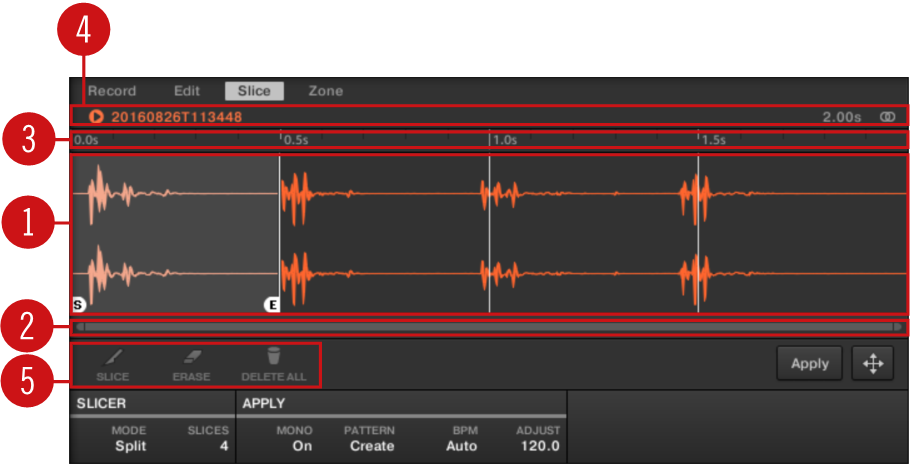
Manually adjusting your Slices.
(1) Waveform display
Shows the selected Sample with a couple of spread vertical lines in the waveform: this is where the Slices are going to be applied (i.e. cut).
Hover a Slice with the mouse to select it (it is highlighted). Little “S” and “E” markers appear at the bottom of the Slice borders to indicate the start and end point of that Slice, respectively.
Use the scroll wheel of your mouse to zoom in/out. You can also use the zooming scroll bar (2).
When the entire Sample or a particular Slice is played back, a playhead indicator (white vertical line) shows you the current play position within the waveform.
Context menu: Right-click (macOS: [Ctrl]-click) anywhere in a Slice to open a context menu with the following commands:
Command | Description |
|---|---|
Open containing folder | Opens the folder on your hard disk containing the Sample, providing quick access to the original file. |
Save Sample As… | Opens a Save Sample As dialog allowing to save the Slice under as a distinct file on your computer. |
By default, you can adjust Slices with your mouse as follows:
Click inside a Slice (i.e. anywhere between its borders) to play it back on the Cue bus (refer to Using the Cue bus for more information).
Drag the borders of a Slice to adjust them. You have two possibilities:
If the end point of the previous Slice and the start point of the next Slice are joined, drag the border’s
vertical lineto move both the end point of the previous Slice and the start point of the next Slice together, so that both Slices stay joined.Drag the little “S” (or “E”)
markerat the bottom of the vertical line to move the start (or end) point of a Slice independently of the end (or start) point of the previous (or next) Slice. If you want this border to stick again with that of the previous (or next) Slice, drag thevertical line(instead of the “S”/“E” marker) toward that of the previous (or next) Slice.
Tip
By moving the start and end points of Slices independently, you can create overlapping Slices or gaps between Slices.
These default mouse actions are valid only if the SLICE and REMOVE buttons are deactivated in the edit tools (5). Enabling any of them provides alternative mouse controls described below.
(2) Zooming scroll bar
Click the main part of the scroll bar and drag your mouse horizontally to scroll through the waveform on the horizontal axis (time), or drag it vertically to zoom in/out on this time axis. You can also click the left or right handle of the scroll bar and drag it horizontally to zoom in/out while keeping the opposite border of the display at a fix position in the waveform. Double-click the main part of the bar to reset the zoom and display the entire waveform. Alternatively you can use the scroll wheel of your mouse when hovering the waveform display (1) to zoom in/out.
(3) Timeline
Shows the time scale in seconds.
(4) Information bar
Displays the file name and the length of the selected Sample. Click and hold the little play icon on the left to play back the whole Sample on the Cue bus (refer to Using the Cue bus for more information). Click the little circle (or pair of circle) at the far right to switch the waveform display (1) between single-channel and two-channel display.
(5) Edit tools
The three buttons in the edit tools allow you to add or remove Slices:
SLICE: When the SLICE button is activated, the default mouse behavior in the waveform display is replaced by the following:
Click inside a Slice to split it into two Slices at that location.
Adjust the borders of existing Slices as described above in the waveform display (1).
REMOVE: When the REMOVE button is activated, over the waveform display the mouse pointer turns into a rubber icon and the default mouse actions are replaced by the following:
Click the start border of a Slice to delete that border and merge the Slice with the previous one.
Click inside a Slice (i.e. anywhere between its borders) to remove the entire Slice. The corresponding part of the Sample is grayed out and won’t be exported as Slice.
DELETE ALL: Click the DELETE ALL button to delete all proposed Slices and start slicing from scratch again.
Notice
The SLICE and REMOVE buttons are mutually exclusive.
Tip
With SLICE or REMOVE activated, you can still prelisten to your individual Slices by pressing the corresponding pads on your controller!
Applying the slicing
Once you are satisfied with the proposed and/or manually adjusted Slices (refer to Adjusting the slicing settings and Manually adjusting your slices), you can apply the slicing in order to actually cut the original Sample and create the Slices. This is done via the three elements at the bottom right of the Slice page:
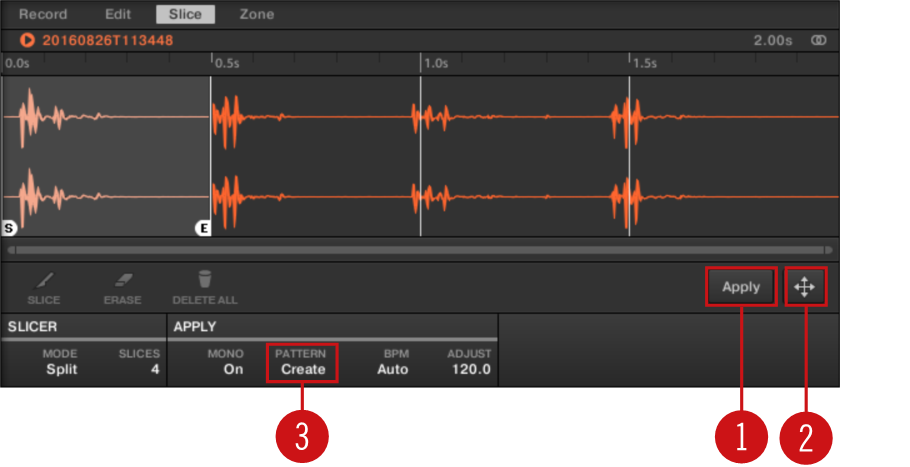
You can apply the slicing in various ways.
(1) Apply button
Exports the Slices to the same Sound. If you click Apply, the Slices will be mapped to individual notes of this Sound, the Sample Editor will be replaced by the Pattern Editor in Keyboard view, and the pads of your controller will switch to Keyboard mode so that you can directly play your Slices on the pads. Additionally, depending on the setting of the Pattern Creation selector (3), some notes can be automatically created for each Slice (see below).
Tip
The Apply button (1) can be seen as a shortcut for dragging the Slice Dragger to the focused Sound itself.
(2) Slice Dragger
Drag the Slice Dragger to export the Slices to any other Sound or Group:
If you drag to a Sound (in the Sound List at the left of the Sample Editor):
The Slices will be mapped to individual notes of this Sound, starting with the bottom C (C-2 in Maschine convention). The base key of the Sound will be set to the bottom C as well (refer to Adjusting the base key for more information on the base key). Any previous content in the Sound will be replaced.
The Sample Editor will be replaced by the Pattern Editor in Keyboard view.
The pads of your controller will switch to Keyboard mode so that you can directly play your Slices on the pads.
Depending on the setting of the Pattern Creation selector (3), notes will be automatically created for each Slice (see below).
If you drag to a Group (in the Group List at the left of the Arranger):
The Slices will be mapped to individual Sound slots, replacing their current content (if any). Only the first 16 Slices will be exported.
The Sample Editor will be replaced by the Pattern Editor in Group view.
The pads of your controller will switch to Group mode so that you can directly play your Slices on the pads.
Depending on the setting of the Pattern Creation selector (3), notes will be automatically created for each Slice (see below).
(3) Pattern Creation selector
Selects from three modes controlling the automatic note creation upon Slice export. The mode selected here will be used both when clicking the Apply button (1) and when using the Slice Dragger (2). Following options are available:
Create Pattern (default setting): Upon Slice export a new Pattern will be created with one note for each pitch (if Slices are exported to a Sound) or one note for each Sound (if Slices are exported to a Group) so that the Pattern reproduces the original, unsliced Sample.
Replace Pattern: Upon Slice export a sequence of notes will be created in the current Pattern so that the Pattern reproduces the original, unsliced Sample. If the sequence is shorter than the current Pattern it will be repeated to fill the Pattern; if the sequence is longer than the Pattern the Pattern will be extended according to the Pattern Grid and the content of other Sounds will be repeated.
If Slices are exported to a Sound, the sequence of notes will contain one note for each pitch. Any existing notes for that Sound will be replaced. Notes for other Sounds in the Pattern will stay untouched.
If Slices are exported to a Group the sequence of notes will contain one note for each Sound containing a Slice. Any existing notes for these Sounds will be replaced. Notes for other Sounds in the Pattern will stay untouched.
No Pattern: No Pattern is created, and the current Pattern is left untouched.
Tip
Play around with the slicing feature by removing some of these notes, quantizing or completely rearranging them.
The notes in the picture above represent the Slices and trigger them in order to play the Sample with correct timing and pitch. If you change the tempo of your Project, you will hear that the loop automatically adjusts to the new tempo.
Exporting single Slices
You can also export an individual Slice to another Sound by drag-and-drop:
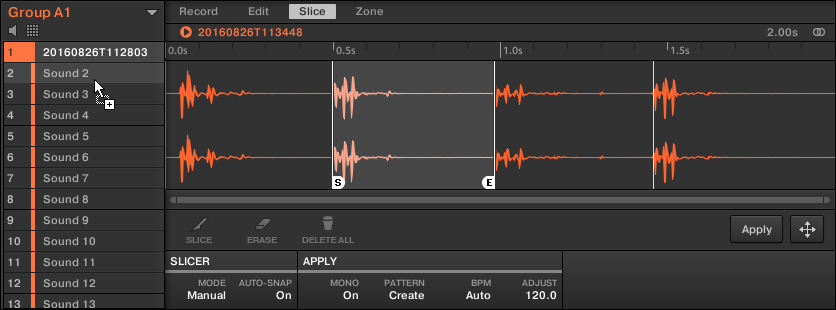
Dragging an individual Slice to another Sound.
Applying a sliced sample to a Sound
If you drag a Slice to a Group in the Group List (at the left of the Arranger), it will be exported to the first Sound slot of that Group. Any Sound loaded in that Sound slot will be replaced.
When applying a sliced sample to a Sound in an otherwise empty Group, the root note of the Sounds in that Group is set to C-2, matching the key zones of the slices.
The root note parameter is shared among all Sounds in a Group. However, when applying slices to a Sound, these slices will always start at the lowest possible note, to make room for the maximum number of slices. If you already have Sounds in a Group, the root note is not changed after applying slices, in order to not change the behavior of the existing Sounds. This will, however, lead to a mismatch in how you accessed slices across Pads in the Sampling / Slice tab and how they are laid out in the Sound you applied them to. You will typically play a root note of C3 with Pad 1, while the lowest slice will start at C-2. To avoid this mismatch, and to access slices on a Sound exactly as you created them in the Sampling / Slice screen, apply slices to a Sound in a Group where you have not loaded anything to the other Sounds. This also works when you start by loading a Sample into a Sound in a Group where you have not yet loaded anything else.
Mapping Samples to Zones
Mapping Samples is a way to create Sounds with more than one Sample across the MIDI keyboard and with different velocities. You can create and adjust Zones that define a key range (or pitch range) and a velocity range for each Sample included in the Sound: The Sample will be triggered only if the played note is within the key range and velocity range of its Zone.
The Zones can overlap, allowing you to trigger different Samples at once or triggering different Samples depending on how hard you hit the pads. You can adjust various playback settings for the Sample of each Zone individually. The set of all Zones define the Sample Map (or “Map” for short) of the Sound.
Opening the Zone page
Mapping is done in the Zone page of the Sample Editor.
Select a Sound slot, then open the Sample Editor (by clicking the button with the waveform icon on the left of the Pattern Editor), and click the Zone tab to show the Zone page.
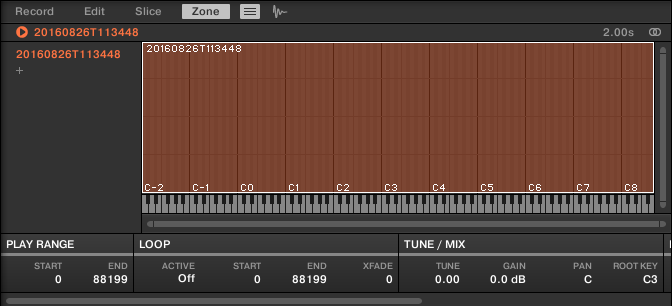
The Zone page (here for an empty Sound).
Zone page overview
The Zone page provides the following elements:
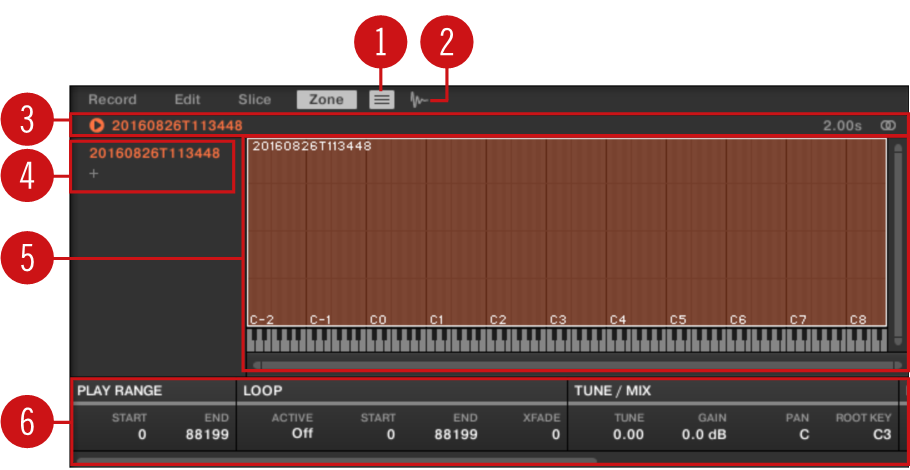
The Zone page: an overview.
(1) Zone List button: Shows/hides the Zone List (4).
(2) Sample View button: Switches the Zone page between Map view and Sample view (5).
(3) Information bar: Displays the file name and the length of the Sample in the focused Zone. Click and hold the little play icon on the left to play back the whole Sample on the Cue bus (refer to Using the Cue bus for more information). Click the little circle (or pair of circle) at the far right to switch the waveform display (1) between single-channel and two-channel display.
(4) Zone List: Shows all Zones in a list. The Zone List can be shown/hidden by clicking the Zone List button (1). Click an entry in the list to set the focus to that Zone. You can also select multiple Zones, move them via drag and drop, and add/delete Zones in the list. See section Selecting and managing Zones in the Zone List for a complete description of the Zone List.
(5) Map view / Sample view: The Map view is the default view (pictured above). It shows and lets you edit all Zones contained in your Sound. The Sample view shows the waveform of the Sample for the focused Zone and lets you edit some of its settings. Click the Sample View button (2) to switch between the Map view and the Sample view (the Sample view is visible when the Sample View button is activated). The Map and Sample views are explained in detail in section Selecting and editing Zones in the Map view and Editing Zones in the Sample view, respectively.
(6) Zone settings: Displays the parameters for the focused Zone. See section Adjusting the Zone settings for a detailed description of the available parameters.
Selecting and managing Zones in the Zone List
On the left, the Zone List shows all Zones of the focused Sound.

The Zone List in the Zone page.
Click the Zone List button next to the Slice tab to show/hide the Zone List.
The Zone List allows you to add, remove, replace, select, and reorder Zones in the list.
Tip
You can adjust the width of the Zone List by dragging its right border.
Adding a new Zone to the Zone List
You can add a new Zone to the Zone List in two ways:
Drag a Sample from the Browser’s LIBRARY or FILES pane or from your operating system onto the empty area in the Zone List.

or
Click the “+” at the end of the Zone List.

A Load Sample dialog opens up.
Navigate to the desired audio file on your operating system and press [Enter] to confirm.
A new Zone is created at the end of the list containing the dragged or selected Sample.
Tip
You can drag and drop several Samples at once, this will create as many new Zones.
Notice
You can also add Zones to your Sound by dragging and dropping Samples directly onto the Sample Map of the Map view. See section Adding Samples to the Sample Map for more on this.
Replacing the sample of an existing Zone
You can also put a new Sample into an existing Zone, thereby replacing the Sample currently contained in that Zone. Again, you have two methods at your disposal:
Drag a Sample from the Browser’s LIBRARY or FILES pane or from your operating system onto the desired entry in the Zone List.

or
Right-click ([Ctrl]-click on macOS) the desired entry in the Zone List and select Load Sample… in the menu that opens.
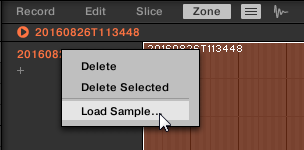
A Load Sample dialog opens up.
Navigate to the desired audio file on your operating system and press [Enter] to confirm.
The dragged or selected Sample replaced the previous Sample in the target Zone.
Selecting a Zone from the list
Click any Zone entry in the Zone List to put it under focus.
The focused Zone gets highlighted in color both in the list and in the Map view (if visible). In addition:
The focused Zone is displayed in the Sample view and its settings appear in the Zone settings at the bottom of the page. See section Adjusting the Zone settings for more information on these settings.
The focused Zone also appears on the Edit and Slice pages, which allows you to further process of its contained Sample. For more information on the Edit and Slice pages, please refer to section Editing a Sample and Slicing a Sample, respectively.
Selecting multiple Zones from the list
You can select several Zones in the list at once using the common methods of your operating system. The basic rules for multiple selection are the following:
The focused Zone is automatically selected. It is highlighted in the color of the Sound and its waveform and parameters are displayed in the Slice page’s Sample view and Zone settings as well as on the Edit and Slice pages.
The other selected Zones are highlighted in white. Their settings are not displayed anywhere, however they will be affected by your actions in the Zone List and in the Map view (refer to Selecting and editing Zones in the Map view for more on this).
Mouse/keyboard action | Command |
|---|---|
Multiple selection | |
Hold [Ctrl] ([Cmd] on macOS) and click several entries in the list | Selects all clicked Zones. Click a selected Zone to deselect it (i.e. remove it from the selection). |
Hold [Shift] and click two entries | Selects both Zones and all Zones in-between. |
Press [Ctrl]+[A] ([Cmd]+[A] on macOS) | Selects/deselects all Zones in the list. When deselecting, only the focused Zone remains selected. |
Deleting Zones from the list
To remove one or more Zone(s) from the Zone List:
Select the Zone(s) you want to remove.
Press [Del] or [Backspace] on your computer keyboard.
The selected Zones are removed from the Zone List and from the Sample Map, and the corresponding Samples are not used in the Sound anymore.
After you have selected the Zone(s) you want to remove, you can also use the context menu:
Select the Zone(s) you want to remove.
Right-click ([Ctrl]-click on macOS) any of the selected Zones.A menu opens up.
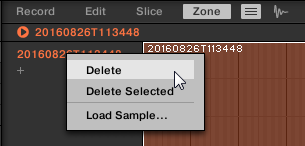
In that menu selects Delete to remove the focused Zone only, or Delete Selected to remove all selected Zones.
Moving Zones in the list
You can move your Zones across the Zone List via drag and drop:
Select the Zone(s) you want to move.
Click and hold the mouse button, and drag your mouse vertically.As the mouse pointer moves, an insertion line appears at various places between the existing entries.
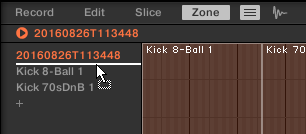
When the insertion line indicates the desired location, release the mouse button to drop the selected Zone(s) to this new place.
Tip
Moving Zones allow you to reorder the Zone List. This can come in handy before you run the Map as Drum Kit command from the Sample Map’s context menu, so that your Samples are well ordered in the new mapping. See section Selecting and editing Zones in the Map view for more information on the Sample Map.
Selecting and editing Zones in the Map view
The Map view is visible when the Sample View button (showing a little waveform icon at the right of the Zone tab) is deactivated.

Disable the Sample View button to see the Map view.
The Map view contains the following elements:
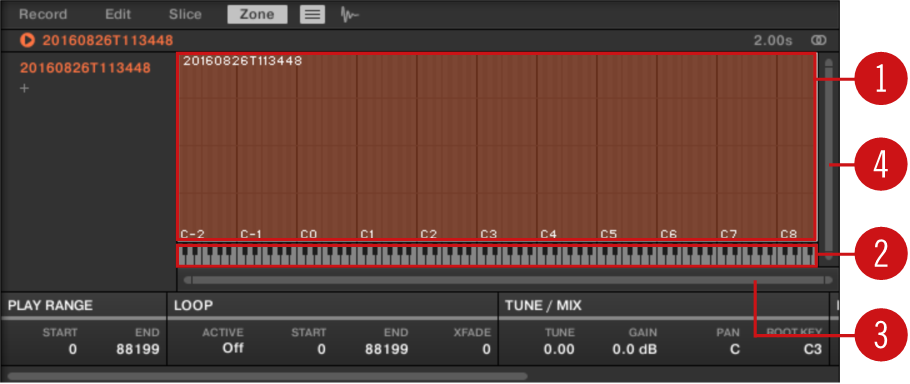
The Map view of the Zone page.
(1) Sample Map
The Sample Map shows all Zones contained in your Sound.
The horizontal axis represents keys (or pitches) from C-2 to G8, while the vertical axis represents velocities from 0 to 127.
Each Zone is depicted as a rectangle defining a specific key range (the rectangle’s width) and a velocity range (the rectangle’s height). Any note played within these key and velocity ranges will trigger the Sample of that Zone.
You can zoom in/out both horizontally and vertically via the zooming scroll bars (3) and (4), respectively.
Each Zone header displays the name of the corresponding Sample.
Click a Zone in the Map to put it under focus. The focused Zone is highlighted; its information and parameters are displayed in the Zone settings at the bottom of the Zone page.
You can select multiple Zones at once: All your mouse actions within the Map view (moving, resizing, etc.) will affect all selected Zones — see the next paragraph for more details on the available selection and edit commands in the Map.
Tip
You can also add a Sample by dragging it directly onto the Sample Map. See section Adding Samples to the Sample Map for more information.
(2) Virtual keyboard
Below the Mapping view, the virtual keyboard represents the entire key scale. The root note of the selected Zone is indicated by the colored key. You can drag this key with the mouse to modify the root key.
(3) Horizontal zooming scroll bar
Click the main part of the scroll bar and drag your mouse horizontally to scroll through the Sample Map on the horizontal axis (pitch), or drag it vertically to zoom in/out on this pitch axis. You can also click the left or right handle of the scroll bar and drag it horizontally to zoom in/out while keeping the opposite border of the display at a fix position in the Sample Map. Double-click the main part of the bar to reset the zoom and display the entire pitch range.
(4) Vertical zooming scroll bar
Click the main part of the scroll bar and drag your mouse vertically to scroll through the Sample Map on the vertical axis (velocity), or drag it horizontally to zoom in/out on this velocity axis. You can also click the top or bottom handle of the scroll bar and drag it vertically to zoom in/out while keeping the opposite border of the display at a fix position in the Sample Map. Double-click the main part of the bar to reset the zoom and display the entire velocity range.
Available actions in the Map
You can select and edit Zones with your mouse and your keyboard in the Map. Following actions are available:
Mouse/keyboard action | Command |
|---|---|
Selection commands | |
Click a Zone | Puts this Zone under focus. The focused Zone is highlighted. You can edit the focused Zone and the playback settings of its Sample via the Zone settings at the bottom of the Zone page, as well as process the Sample’s audio material on the Edit page and/or slice the Sample on the Slice page. |
Hold [Ctrl] ([Cmd] on macOS) and click several Zones | Selects all clicked Zones. Click a selected Zone to deselect it (i.e. remove it from the selection). |
Hold [Shift] and click two Zones | Selects both Zones and all Zones in-between. |
Click and drag a selection frame in the Sample Map | Selects all Zones within or overlapping the frame. |
Press [Ctrl]+[A] ([Cmd]+[A] on macOS) | Selects/deselects all Zones. When deselecting, only the focused Zone remains selected. |
Edit commands | |
Drag the left/right border of a Zone | Adjusts the key range for the selected Zones. |
Drag the higher/lower border of a Zone | Adjusts the velocity range for the selected Zones. |
Drag a corner of a Zone | Simultaneously adjusts the lowest/highest note and the lowest/highest velocity of the selected Zone(s) — depending on the corner. |
Click inside a Zone and drag | Moves the selected Zone(s) across the Sample Map. Note that the Root Key of each Zone is moved accordingly. |
Double-click a Zone | Extends the key and velocity ranges of the Zone so that it fits the key and velocity limits of the neighbor Zones. This can be very useful to quickly fill up any key or velocity gap between Zones. |
Right-click ([Cmd]-click on macOS) a Zone | Opens the Sample Map menu (see below). |
Press [Del] or [Backspace] | Removes the selected Zone(s) from the Sample Map. |
Tip
You can also adjust the key and velocity ranges in the Zone settings at the bottom of the Zone page. See Adjusting the Zone settings for a detailed description.
Tip
For more information on the Edit and Slice pages, please refer to section Editing a Sample and Slicing a Sample, respectively.
Sample Map menu
The Sample Map menu contains additional editing facilities.
Right-click ([Ctrl]-click on macOS) a Zone to open the Sample Map menu.
The commands in the Sample Map menu will affect all selected Zones. The menu provides following commands:
Command | Description |
|---|---|
Delete | Removes the selected Zone(s) from the Sample Map. |
Map as Drum Kit | Reduces the selected Zones to one note over the full velocity range and puts the Zones next to each other upwards from the middle C (C3). The actual note assigned to each Zone depends on the Zone position in the Zone List: The topmost Zone will be mapped to middle C (C3), the Zone underneath to C#3, etc. |
Editing Zones in the Sample view
The Sample view is visible when the Sample View button (showing a little waveform icon at the right of the Zone tab) is activated.

Enable the Sample View button to see the Sample view.
The Sample view contains the following elements:
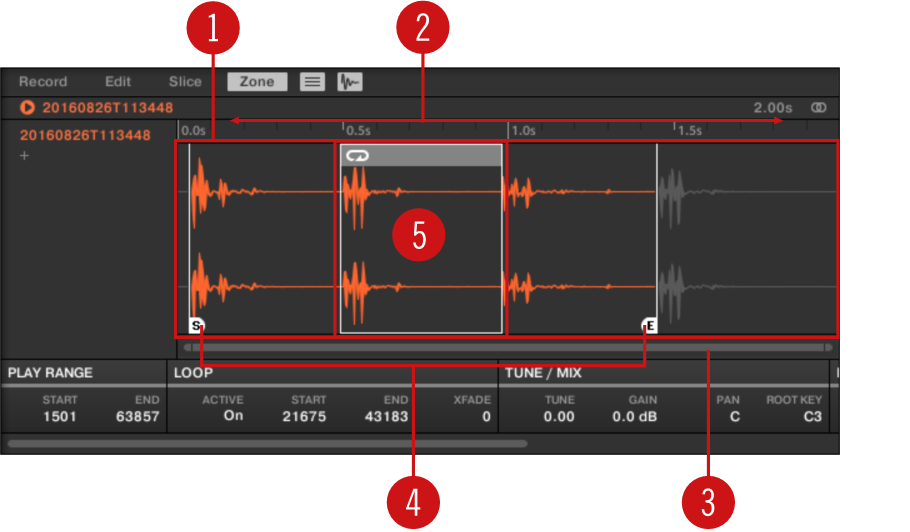
The Sample view of the Zone page.
(1) Waveform display
Shows the waveform of the Sample for the focused Zone. The waveform display provides following tools:
Use the scroll wheel of your mouse to zoom in/out. You can also use the zooming scroll bar (3).
Play range markers (4) and loop markers (5): See below.
Playhead indicator: When the Sample is played back (e.g., by pressing the pad or by clicking the little play icon in the information bar above the waveform), a playhead indicator (white vertical line) shows you the current play position within the waveform.
Context menu: Right-click (macOS: [Ctrl]-click) anywhere in the waveform to open a context menu with the following commands:
Command | Description |
|---|---|
Open containing folder | Opens the folder on your hard disk containing the Sample, providing quick access to the original file. |
Save Sample As… | Opens a Save Sample As dialog allowing to save the Sample of the focused Zone under another name and/or to another location on your computer. |
(2) Timeline
Shows the time scale in seconds.
(3) Zooming scroll bar
Click the main part of the scroll bar and drag your mouse horizontally to scroll through the waveform on the horizontal axis (time), or drag it vertically to zoom in/out on this time axis. You can also click the left or right handle of the scroll bar and drag it horizontally to zoom in/out while keeping the opposite border of the display at a fix position in the waveform. Double-click the main part of the bar to reset the zoom and display the entire waveform. Alternatively you can use the scroll wheel of your mouse when hovering the waveform display (1) to zoom in/out.
(4) Play range markers
The S and E markers indicate the start and end points of the play range, respectively. Drag them with the mouse to modify the portion of the Sample that will be played back. This can also be done in the PLAY RANGE section of the Zone settings, under the waveform display (refer to Adjusting the Zone settings).
(5) Loop markers
If a loop has been defined in the Sample, it is also indicated on the waveform. You can then adjust the loop by dragging its borders, and move the entire loop by dragging its title bar. Loops can be created and adjusted in the LOOP section of the Zone settings, under the waveform display (refer to Adjusting the Zone settings). Note that the loop will always stay within the play range. Therefore, when moving the Sample’s start and end points closer to each other (see above), keep in mind that it might also shrink the loop!
Adjusting the Zone settings
At the bottom of the Zone page, the Zone settings allow you to adjust how each Zone should be played back.

The Zone settings in the software.
The various sections always display the values for the focused Zone.
Notice
If the Maschine window is not wide enough to display all Zone settings at once, a horizontal bar appears underneath to scroll to the desired section of parameters.
Following parameters are available:
(1) PLAY RANGE section
The parameters in the PLAY RANGE section allow you to adjust the portion of Sample that will be played back when the Zone is triggered.
Parameter | Description |
|---|---|
START | Adjusts the playback’s start point in the Sample of the focused Zone. |
END | Adjusts the playback’s end point in the Sample of the focused Zone. |
(2) LOOP section
The parameters in the LOOP section allow you to define and adjust a portion that will play in loop while the note is held.
Parameter | Description |
|---|---|
ACTIVE | Enable this to define a loop in the Sample of the focused Zone. When the play position reaches the loop, the playback is looped as long as the note is held. This can be useful to loop either a whole Sample or part of it, e.g., to simulate a longer tone. Note: this technique requires that you set the Sampler’s Type selector to AHD or ADSR on the Pitch / Envelope page (refer to Page 2: Pitch / Envelope). |
START | Adjusts the loop’s start point. |
END | Adjusts the loop’s end point. |
XFADE (Crossfade) | Allows you to blend a little of the material near the loop start and end points in order to get a smoother, less abrupt loop. This is particularly helpful if the loop is inducing any clicks. |
Alternatively you can also adjust the loop’ start and end points by dragging the borders of the loop in the Sample view, and move the entire loop by dragging its title bar.
Tip
By moving the loop’s start and end points closer to each other you can shrink the loop to very small values on-the-fly, thereby creating very interesting glitch effects in a live situation.
Notice
The loop will always stay within the play range of the Sample. Therefore, when moving the Sample’s playback start and end points closer to each other, keep in mind that it might also shrink the loop!
(3) TUNE / MIX section
The TUNE / MIX section contains parameters controlling pitch- and level-related aspects of the Sample playback.
(4) ENVELOPE section
This amplitude envelope can be used to get rid of clicks after slicing; you can either apply it to the Zone of the whole Sample or to individual Zones for selected Slices.
Parameter | Description |
|---|---|
ATTACK | Adjusts how quickly the Sample/Slice reaches full volume after being triggered. |
DECAY | Adjusts how fast the Sample/Slice dies down. |
(5) MAP section
The MAP section contains the parameters defining the key and velocity ranges of the Zone.
Parameter | Description |
|---|---|
KEY LO (Lowest Key) | Sets the lowest note (key) of the focused Zone. Alternatively, you can drag the left border of the Zone in the Map. |
KEY HI (Highest Key) | Set the highest note (key) of the focused Zone. Alternatively, you can drag the right border of the Zone in the Map. |
VEL LO (Lowest Velocity) | Defines the lowest velocity of the focused Zone. Alternatively, you can drag the lower border of the Zone in the Map. |
VEL HI (Highest Velocity) | Defines the highest velocity of the focused Zone. Alternatively, you can drag the higher border of the Zone in the Map. |
Adding Samples to the Sample Map
You can add Samples directly to the Map view of the Zone page.
Tip
To see the Map view, make sure that the Sample View button is deactivated next to the Zone tab at the top of the Sample Editor. If this is not the case, click it to disable it.
To add a new Sample, select one from the Browser or from your operating system and drag it onto the Sample Map of the Map view (the biggest part in the middle of the Zone page). Once your mouse is hovering the Sample Map, and
beforeyou release the mouse button:
Drag your mouse horizontally to choose the root key of the new Zone.
Drag your mouse vertically to adjust the key range: With your mouse in the lower half of the Sample Map the Zone will cover the root key only; dragging your mouse up in the upper half of the Sample Map will extend the Zone’s key range up to one octave above the root key; with your mouse at the top of the Sample Map, the Zone will cover the entire keyboard.
As you release the mouse button, the Zone is created.
You can add other Samples to the Sound via this method.
The key range of several Zones can overlap, as can the velocity range.
Adding multiple Samples at once
You can also drag several Samples to the Sample Map at once:
Hold [Ctrl] ([Cmd] on macOS) or [Shift] on your computer keyboard and click the desired Samples in the Browser or in your operating system.
Drag the selected Samples to the Sample Map.
This will create multiple adjacent Zones. The width (i.e. key range) of these Zones will again depend on where they are dropped in the Sample Map: The higher you drop, the wider each Zone will be. Dragging to the top part layers all Zones across the entire keyboard.
The placement of the Zones depends on the original Samples’ position in the selection list: The first Sample selected will get the Zone with the lowest key range, the second Sample selected will get the Zone just over the previous one, etc.
